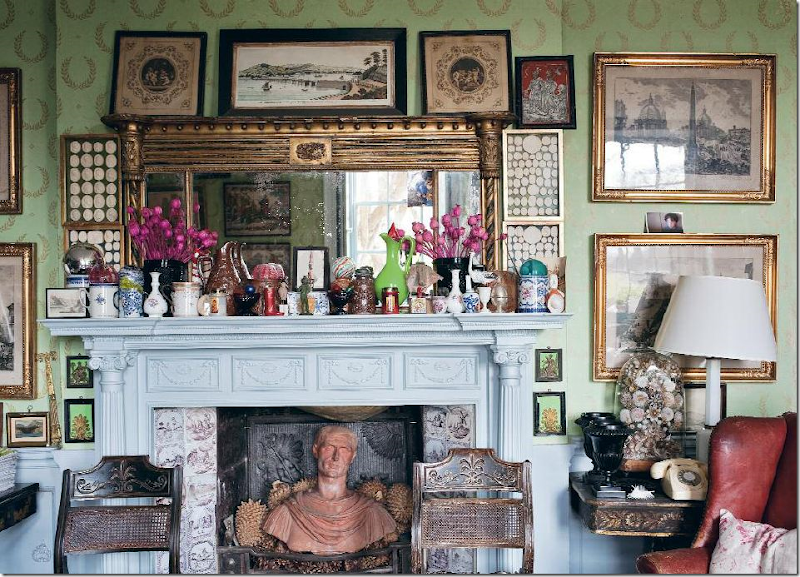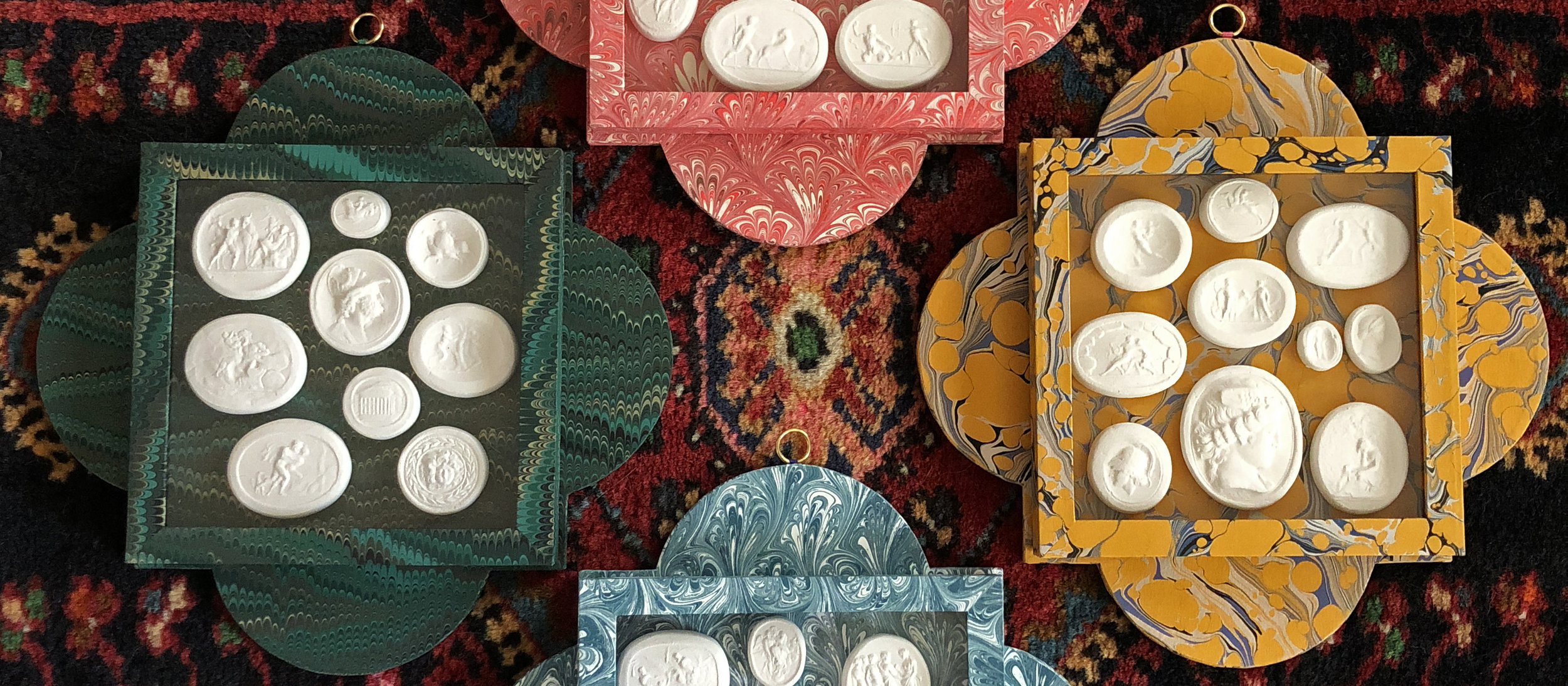Well, once again Steven Gambrel hurls me into a rabbit hole of inspiration. He does that from time to time. This particular occasion, I was perusing his book Time & Place when I stumbled upon the below image and couldn’t overt my eyes. Just about every interior designer in the world has displayed intaglios in frames on the wall, but I’d never seen a side table collection.
“A pair of 1950s Jansen-designed tables with vitrines of intaglios” Steven Gambrel
My young eyes first encountered framed intaglios in my childhood home. My parents had a few framed in their master bathroom. But it wasn’t until I took my first Art History class (which I later pursued a degree in) that I really learned what they were all about.
A set of 15 Italian plaster intaglio impressions from the first half of the 19th century sold for over $13,000 through Christie’s.
Intaglio means “carving” in Italian, and is often used to describe a little engraved stone or plaster keepsake collected by travelers during the Grand Tour in the 17th and 18th centuries — a period of time when young well-to-do boys (and sometimes girls) would leave the nest and travel Western Europe.
Sir John Soane did a Grand Tour at the age of 23, later becoming one of the world’s most renowned neo-classical architects, eventually amassing the above collection of antiquities, furniture, sculptures, architectural models, paintings, and over 30,000 architectural drawings — which you can view in London at the Sir John Soane Museum.
On this sort of “educational rite of passage,” often accompanied by a tutor, they would learn about music, art and architecture, rub elbows with other affluent individuals — and collect intaglios along the way. These hand-carved souvenirs, usually illustrating scenes from Greek or Roman mythology, or historic events or figures, were believed to attract good luck and health. My dad’s architectural firm published a fascinating two-part series on the Grand Tour here, if you’re a history lover.
Ornately framed intaglios from the 19th century sold on Sotheby’s.
A. Tyner Antiques wrote a nice summary of Grand Tour intaglios: “The travelers would mount the intaglios into books and then make notes corresponding to each one as to his adventure that resulted in his buying or obtaining that stamp. By the end of the trip a traveler would have books filled with intaglios and notes that would last a lifetime, and were perfect tools for telling children stories about their adventures in the world beyond the county line.”
Set available via 1stdibs. “Original set of Grand Tour plaster intaglios. Inside the front and back cover is a hand written key describing the images on each of the cameos. The individual cameos were cast from carved stone intaglios to serve as souvenirs and collectors' items.”
An giltwood obelisk mounted with 45 19th Century Grand Tour plaster intaglios.
In the design world, they’ve been popular since…well, forever. Many well-known designers have used framed intaglios throughout their designs – Suzanne Kasler, Phoebe Howard, and Alexa Hampton, just to name a few. Just by perusing the internet, you can see that framed intaglios were definitely having a moment in the early 2000s — you’ll see a lot of design blogs ooh-ing and ahh-ing over them starting around 2009, when blogs were becoming mainstream. I stumbled upon another blog post published in 2011 that poses the question “Are Intaglios Still Trending?”. (The answer was yes).
Today, Tiberian Design, who possesses one of the largest known collections of 18th and 19th century intaglios, consider themselves “the pioneer of the modern framed intaglio.” Lately, I have not seen an overabundance of these little classical plaster reliefs being used, but if I were a betting (wo)man I’d say they’ll have their moment again (and again and again), like all things timeless.
Design and Image by Suzanne Kasler
Design and Image by Katie Ridder
Design by Ivy and Vine / Image by Atlanta Homes & Lifestyles
19” century intaglios hidden amidst a deliciously cluttered mantle at Hanham Court , the historic house owned by famed garden designing couple — Julian and Isabel Bannerman.
Left: Legendary American fashion designer Bill Blass was a lover of antiquities. Right: Bill near his collection of intaglios. Source.
A fresh and creative way to display intalgios - via Pentreath & Hall
I just love this current take on the ancient art form Bridie Hall
Design and Image via Jenny Wolf
Available for purchase via Parvum Opus
Available for purchase via Parvum Opus
These timeless, versatile, intricately detailed pieces are a beautiful way to add interest to any space, but admittedly can get pretty pricey. People shell out thousands for genuine historic pieces on Christie’s, 1stDibs and Sotheby’s. You can purchase framed, museum-quality (reproduction) intaglios from Tiberian Design on Etsy. You can also find them sold by Ballard. Locally, you can usually find a beautiful assortment at Paloma & Co. If you’re a little crafty and think you can handle the display aspect yourself, Plaster Craft sells sets of reasonably priced great looking reproduction Grand Tour intaglios.
Gorgeous display of intaglios at one of my favorite Houston shops, Paloma & Co.
A very funky rainbow intaglio lamp by colorful Bridie Hall.
And when these little gems of plaster are no longer enough to satiate your love of antiquities, you turn into “Master Plaster Caster” Peter Hone — known for his eclectic hoard of carvings, marble busts, urns, architectural fragments, Roman and Greek statues and various stone sculptures.
“Master Plaster Caster” Peter Hone at home in London’s Notting Hill. via Christie’s
Peter Hone via Christie’s
More on Peter Hone some other time. You just KNOW he’s got a story to tell…

























